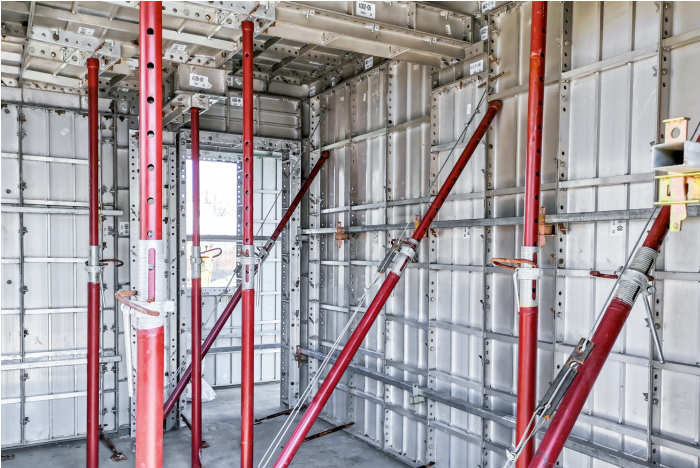What Is Formwork?

Struggling to achieve perfect concrete structures? Formwork provides the essential temporary framework for shaping, supporting, and stabilizing concrete, ensuring safety, precision, and durability in construction projects.
Formwork is a temporary mold used to shape and support wet concrete until it hardens. Essential in construction, it ensures structural integrity, precise dimensions, and smooth finishes for concrete components.
Below, we explore the types, benefits, components, and best practices for using formwork in construction to help you build safe, high-quality, and cost-effective concrete structures.
What Is Formwork in Construction?
Wondering what formwork is? It’s a critical tool in construction, ensuring concrete structures are shaped accurately, supported during curing, and finished with precision.
Formwork is a temporary structure used in construction to mold, support, and contain wet concrete. It provides stability, precision, and safety, ensuring durable and high-quality concrete structures.
Formwork refers to a temporary or permanent mold into which wet concrete is poured and supported until it hardens. It plays a key role in:
- Shape Formation: Defines the shape and dimensions of concrete components.
- Support: Prevents collapse during curing.
- Surface Finish: Ensures smooth and even finishes.
It’s a crucial element in modern construction for achieving stable and precise concrete structures.
What Are the Benefits of Formwork in Construction?
Curious about the advantages? Formwork ensures safety, efficiency, and precision in concrete construction, making it an essential tool for high-quality and cost-effective building projects.
Formwork provides multiple benefits, including improved safety, reduced construction time, better surface finishes, and reusability. These features make it an essential component for efficient and high-quality construction processes.
Benefits of using formwork in construction include:
- Safety: Stabilizes wet concrete, minimizing risks during pouring and curing.
- Efficiency: Speeds up construction, saving time and labor.
- Surface Quality: Delivers smooth and precise concrete finishes.
- Cost Savings: Reusable formwork reduces material costs.
- Durability: Ensures proper curing for strong and reliable structures.
Formwork’s advantages make it indispensable for achieving quality and efficiency in construction.
What Are the Types of Formwork?
Confused about the types of formwork? From traditional timber to advanced aluminum systems, formwork choices cater to diverse project needs, ensuring efficiency and quality in construction.
Types of formwork include timber, plywood, steel, aluminum, and plastic. Each type offers unique benefits, making it suitable for specific project requirements, budgets, and construction timelines.
The primary types of formwork include:
- Timber Formwork: Cost-effective and easy to use for small-scale projects.
- Plywood Formwork: Lightweight with a smooth surface finish.
- Steel Formwork: Durable and reusable for large-scale projects.
- Aluminum Formwork: Corrosion-resistant and lightweight for high-rise buildings.
- Plastic Formwork: Ideal for repetitive tasks in large projects.
The selection depends on factors like project scale, budget, and desired finish.
What Is the Best Formwork to Use?
Looking for the best option? The ideal formwork depends on the project, but steel, aluminum, and plastic systems often provide durability, efficiency, and cost-effectiveness for modern construction.
The best formwork depends on the project’s scale and requirements. Steel is durable, aluminum is lightweight and corrosion-resistant, and plastic is ideal for repetitive tasks in large-scale projects.
The best formwork for construction depends on:
- Steel Formwork: Ideal for durability and reuse in large projects.
- Aluminum Formwork: Lightweight and corrosion-resistant, suitable for high-rise buildings.
- Plastic Formwork: Best for repetitive tasks and easy handling.
- Plywood Formwork: Offers smooth finishes at an economical cost.
Choosing the best type depends on the project scale, budget, and structural requirements.
What Are the Components of Formwork?
Unsure about formwork components? Properly designed systems include panels, braces, ties, and supports to shape, stabilize, and secure concrete structures during the curing process.
Formwork consists of components like sheathing, studs, footing, ties, and braces. These elements work together to mold, stabilize, and support wet concrete during construction.
The key components of formwork include:
- Sheathing (Panels): Creates the mold for the concrete.
- Studs: Vertical framing members that support walls and distribute loads.
- Footing: Distributes the weight of the structure to the ground.
- Ties: Hold formwork components together.
- Braces: Ensure alignment and prevent lateral movement.
Each component is vital for ensuring the stability and precision of the structure.
What Are the Best Practices for Using Formwork in Construction?
Looking to optimize formwork use? Proper handling, regular inspections, and adherence to specifications ensure safety, durability, and cost-efficiency in construction projects.
Best practices for formwork include using high-quality materials, inspecting components regularly, and following design specifications. Proper handling and maintenance extend formwork life and improve construction outcomes.
Best practices for formwork use include:
- Adhering to Design Specs: Ensure stability by following plans.
- Inspecting Regularly: Check for damages before each use.
- Using Durable Materials: Invest in quality for better performance.
- Proper Handling: Avoid rough treatment to extend lifespan.
- Removing Formwork Safely: Prevent damage by adhering to curing timelines.
These measures guarantee safe and high-quality construction results.
Conclusion
Formwork is an essential component in construction, providing the support and shape needed for concrete structures. By understanding its importance, types, and best practices, you can achieve safe, efficient, and cost-effective building processes.
